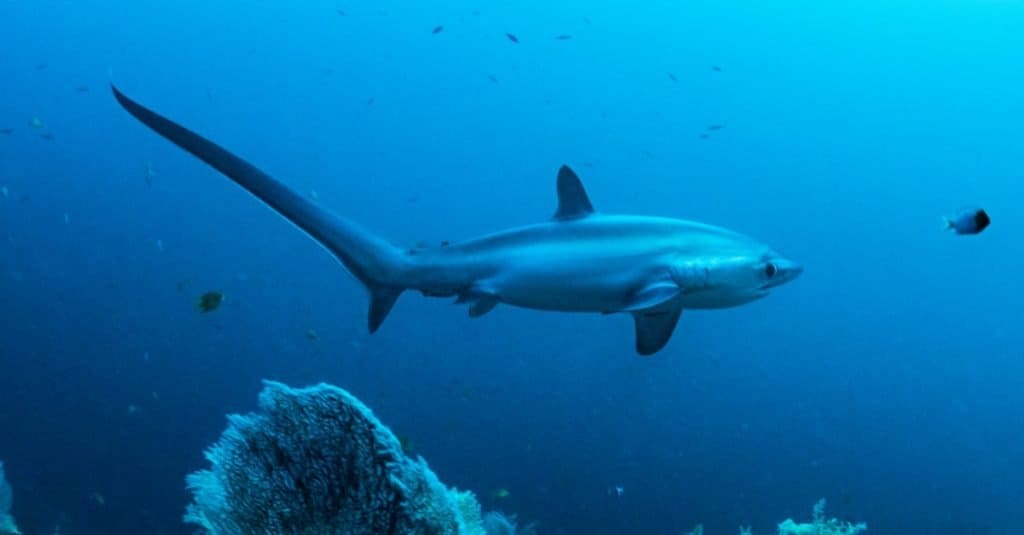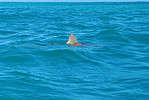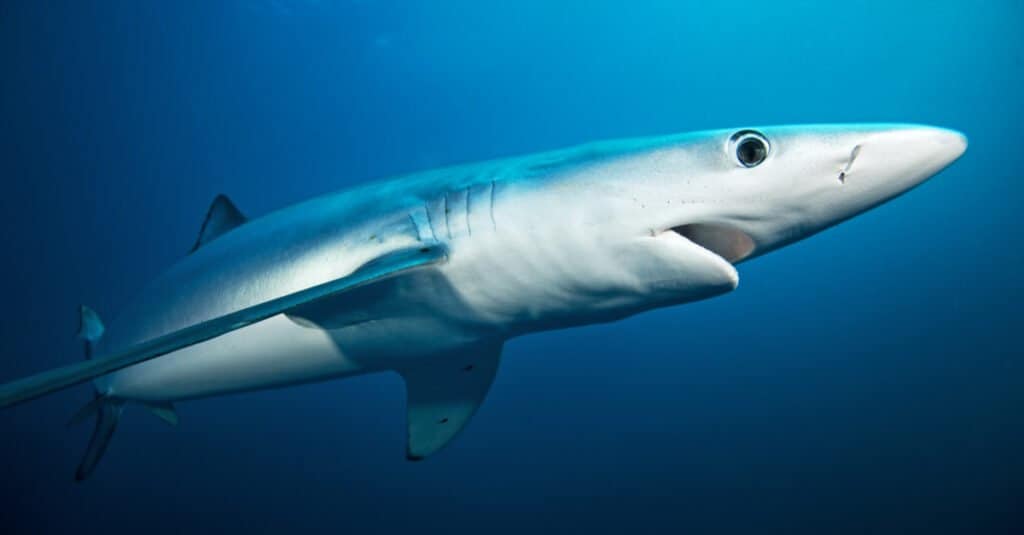
In the seemingly tranquil waters surrounding the United Kingdom, a hidden world of remarkable marine creatures awaits in its depths. Among these captivating inhabitants are various types of sharks! While the UK doesn’t have the Great White, the country does boast some of the largest sharks in the world.
So, today, let’s get to know the biggest sharks in UK waters.
In this article, we’ll dive into the depths of the ocean together and get to know these terrifying creatures, exploring their appearances, habitats, and behaviors.
1. Basking Shark (Cetorhinus Maximus) – 40 ft; 10,000 lbs

The basking shark is the biggest shark in the UK, reaching up to 40+ feet long!
©Martin Prochazkacz/Shutterstock.com
The biggest shark in the UK is the basking shark. In fact, it is the second-largest fish in the world, reaching lengths of up to 40+ feet and weighing up to 10,000 pounds or more. Despite its massive size, the basking shark is a gentle giant and usually poses no threat to humans. It has a distinctive appearance with a large, gaping mouth and a blunt snout. Its body is greyish-brown, and its skin is rough, covered in denticles that provide protection and aid in swimming.
The basking shark is a filter feeder, subsisting mainly on planktonic organisms such as krill, copepods, and small fish. It feeds by swimming slowly near the surface, opening its mouth wide to allow water to flow through. As water passes through its gill rakers, the basking shark filters out the microscopic prey, consuming vast amounts of plankton.
These sharks prefer temperate and cold waters and live in coastal areas and around islands, including in the waters around the United Kingdom. During the summer, they may migrate to areas with higher plankton concentrations. Basking sharks form aggregations, where multiple individuals gather in the same area to feed.
Conservation efforts are crucial for the basking shark, as it has faced historical threats from commercial fishing. It is now protected in many regions to ensure its continued survival. By understanding its habits, movements, and preferred habitats, researchers can work towards preserving this magnificent species and its essential role in the marine ecosystem.
2. Greenland Shark (Somniosus microcephalus) – 24 ft; 2,400 lbs

Weighing up to 2,400 pounds, the Greenland shark is the second biggest shark in UK waters.
©Dotted Yeti/Shutterstock.com
The Greenland shark also lives in the United Kingdom’s frigid waters, particularly in the deeper regions. It is one of the largest shark species, capable of reaching up to 24 feet long. And they’ll generally weigh up to 2,400 pounds. Despite its impressive size, the Greenland shark has a relatively sluggish appearance, with a stocky body and a rounded snout. Its skin is dark gray or black, and its body is often covered with scars and parasites, giving it a rugged appearance.
The Greenland shark has a unique and intriguing diet, primarily consisting of fish, including species found in the cold northern waters. Additionally, it feeds on seals, smaller sharks, and carrion. This species is a known scavenger, often feasting on carcasses that sink to the ocean floor. Its slow metabolism and ability to tolerate low temperatures allow it to survive in the frigid Arctic waters.
Habitat-wise, the Greenland shark is commonly found in the subarctic and Arctic regions, including areas near the United Kingdom. It prefers deep, cold waters and swims at depths exceeding 2,000 meters (6,560 feet). The species migrates vast distances and can inhabit both coastal and offshore waters.
Given its elusive nature and deep-sea habitat, encounters with the Greenland shark are infrequent, and it poses no significant threat to humans.
3. Smooth Hammerhead Shark (Sphyrna zygaena) – 16 ft; 880 lbs

Growing up to 16 feet long, the smooth
hammerhead shark
can weigh up to 880 pounds.
©iStock.com/Michael Zeigler
The smooth hammerhead shark is one of several species within the hammerhead shark family known for its distinctive head shape. Its head famously has elongated, laterally extended lobes on either side. The smooth hammerhead shark can grow up to 16 feet long and weigh up to 880 pounds. It has a slender body with a grayish-brown or olive-brown coloration on its back, fading to a lighter shade on its underside.
As an opportunistic predator, the smooth hammerhead shark has a diverse diet, including various fish species and smaller sharks. It also feeds on crustaceans and squid. Scientists believe that its unique head shape enhances the shark’s sensory capabilities, aiding in detecting and capturing prey.
Smooth hammerhead sharks typically live in temperate and tropical waters, including the waters surrounding the United Kingdom. They inhabit both coastal and offshore areas. These sharks undertake long-distance migrations following prey availability and water temperature changes.
While encountering smooth hammerhead sharks in the UK is relatively rare, they are generally non-aggressive toward humans.
4. Common Thresher Shark (Alopias vulpinus) – 16 ft; 600 lbs

Interestingly, the common thresher shark’s tail can be as long as the its body.
©Shane Gross/Shutterstock.com
The common thresher shark has a great tail, which can be as long as the shark’s body. These sharks can measure to up 16 feet long and weigh up to 600 pounds, with females generally much bigger than their male counterparts. The common thresher shark has a streamlined body, a distinctive crescent-shaped tail, and a dark blue or grayish-brown coloration on its back, gradually fading to a lighter shade on its underside.
When it comes to diet, the common thresher shark primarily feeds on small schooling fish such as mackerel and sardines. It uses its long, whip-like tail to stun or herd its prey. This hunting technique is a remarkable adaptation that sets the common thresher shark apart.
These sharks are highly migratory, and their habitat can vary depending on the season. During the warmer months, they often swim in the coastal waters around the United Kingdom, but they may venture farther offshore in colder seasons.
Encounters with the common thresher shark in the UK are relatively uncommon, as they typically occur in deeper waters. However, they are generally shy and pose little threat to humans when encountered. Understanding their behaviors, migration patterns, and population dynamics is crucial for their conservation and management. This is particularly important because the common thresher is considered vulnerable, as, unfortunately, it does not reproduce quickly.
5. Shortfin Mako Shark (Isurus oxyrinchus) – 13 ft; 1,250 lbs

One of the fastest sharks is the shortfin mako shark.
©Xavier ELIAS Photography/Shutterstock.com
The shortfin mako shark is another remarkable species that lives in the waters surrounding the United Kingdom. Due to its incredible speed and agility, this shark is one of the fastest swimming sharks in the ocean. The shortfin mako shark can reach up to 13 feet long and weigh up to 1,250 pounds. This shark has a sleek and slender body that allows them to glide effortlessly through the water. It also is a deep blue or metallic gray in color, but this color fades to a lighter shade on the underside of the shark.
The shortfin mako shark is an apex predator, and its diet primarily consists of bony fish such as mackerel, tuna, and swordfish. It can also prey on smaller sharks and squid in some cases. The shortfin mako shark is a highly efficient hunter, equipped with a long, slender body and a mouthful of sharp, serrated teeth.
These sharks inhabit offshore and pelagic regions, commonly found in temperate and tropical waters worldwide. While they prefer deeper waters, these sharks may sometimes swim around closer to the coast. Shortfin mako sharks are highly migratory and often travel long distances, exhibiting impressive navigational abilities.
Although shortfin mako sharks are dangerous predators, they pose minimal threat to humans and are generally not aggressive unless provoked. Encounters with these magnificent creatures are rare, but they contribute to the diverse marine ecosystem of the UK’s waters.
6. Porbeagle Shark (Lamna nasus) – 12 ft; 500 lbs

Porbeagle sharks can reach up to 12 feet long and weigh up to 500 pounds.
©ANPerryman/ via Getty Images
The porbeagle shark is another species living in the waters around the United Kingdom. It can reach up to 12 feet long and weigh up to 500 pounds. The porbeagle shark has a stout, streamlined body and a pointed snout. Its coloration varies, but it generally has a dark gray or bluish-gray back with a lighter underside.
As an active predator, the porbeagle shark has a diverse fish diet. It preys on various species, including mackerel, herring, and other small to medium-sized fish in its habitat. Porbeagles are known for their powerful jaws and sharp teeth, enabling them to capture and consume their prey efficiently and quickly.
Porbeagle sharks inhabit temperate and cold waters commonly found in the North Atlantic Ocean, including the seas around the UK. They prefer deeper offshore areas and are known to undertake extensive migrations at times. These sharks can be found at various depths, from near the surface to 2,300 feet (700 meters) deep.
Encounters with porbeagle sharks in the UK are relatively rare and generally not considered a threat to humans. However, they are highly valued by sports fishermen due to their strength and fighting ability.
7. Blue Shark (Prionace glauca) – 11 ft; 401 lbs

Although large, blue sharks are not generally aggressive and will shy away if approached.
©Martin Prochazkacz/Shutterstock.com
The blue shark is known for its slender and streamlined body, reaching up to 11 feet long and 401 pounds in weight. The blue shark has a distinctive coloration with a deep indigo-blue hue on its upper side, transitioning to a vibrant blue or white on its underside. Its sleek appearance allows it to navigate the ocean with remarkable agility.
As an opportunistic predator, the blue shark has a diverse diet of various marine organisms. Its menu primarily includes small schooling fish such as sardines, herring, and mackerel, but it also feeds on squid, crustaceans, and even carcasses when available. The blue shark is known for its excellent swimming abilities and can cover vast distances for food.
Blue sharks inhabit both coastal and offshore waters, favoring temperate and tropical regions. They are generally found in the open ocean and are known to venture close to the coast during their migrations. The UK’s waters offer a suitable habitat for these sharks, often appearing in deeper offshore areas or areas where warm currents converge.
Although the blue shark is a relatively large fish species, encounters with humans are rare and considered non-aggressive. These sharks are usually shy and will swim away if approached.
Summary of the Biggest Sharks in UK Waters
| Rank | Shark | Max Length | Max Weight |
|---|---|---|---|
| 1 | Basking Shark | 40 feet | 10,000 pounds |
| 2 | Greenland Shark | 24 feet | 2,200 pounds |
| 3 | Smooth Hammerhead Shark | 16 feet | 880 pounds |
| 4 | Common Thresher Shark | 16 feet | 600 pounds |
| 5 | Shortfin Mako Shark | 13 feet | 1,250 pounds |
| 6 | Porbeagle Shark | 12 feet | 500 pounds |
| 7 | Blue Shark | 11 feet | 401 pounds |
The photo featured at the top of this post is © Dotted Yeti/Shutterstock.com
Thank you for reading! Have some feedback for us? Contact the AZ Animals editorial team.






